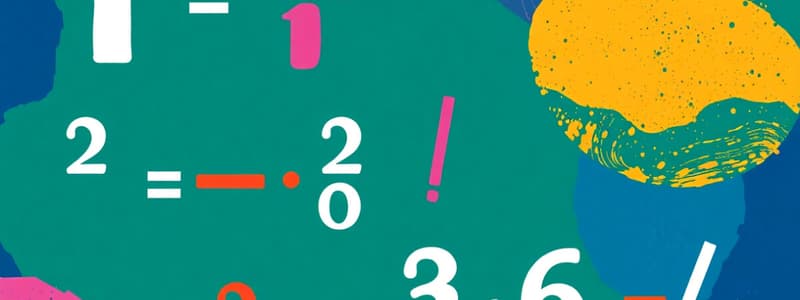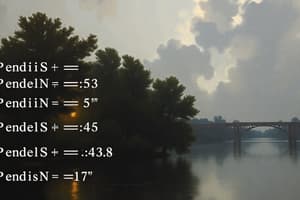Podcast
Questions and Answers
Which of the following best describes mathematics?
Which of the following best describes mathematics?
- The study of living organisms
- The study of the Earth's atmosphere
- The abstract science of number, quantity, and space (correct)
- The study of chemical reactions
What are the four basic arithmetic operations?
What are the four basic arithmetic operations?
- Addition, subtraction, multiplication, and exponentiation
- Addition, subtraction, multiplication, and division (correct)
- Addition, differentiation, multiplication, and division
- Addition, subtraction, division, and integration
What does PEMDAS/BODMAS dictate?
What does PEMDAS/BODMAS dictate?
- The types of numbers to use in a problem.
- The order in which to write a mathematical proof.
- The tools needed to solve the problem.
- The sequence in which calculations are performed. (correct)
In algebra, what is a variable?
In algebra, what is a variable?
What is the highest power of the variable in a linear equation?
What is the highest power of the variable in a linear equation?
Which field of math studies the relationships of points, lines, surfaces, and solids?
Which field of math studies the relationships of points, lines, surfaces, and solids?
Who is Euclidean geometry based on axioms and postulates by?
Who is Euclidean geometry based on axioms and postulates by?
Identify the hypotenuse In the Pythagorean theorem $a^2 + b^2 = c^2$.
Identify the hypotenuse In the Pythagorean theorem $a^2 + b^2 = c^2$.
Which shape is classified as a quadrilateral?
Which shape is classified as a quadrilateral?
What is the term for the distance from the center of a circle to its edge?
What is the term for the distance from the center of a circle to its edge?
What does 'area' measure?
What does 'area' measure?
What is the focus of trigonometry?
What is the focus of trigonometry?
Which of these is a trigonometric function?
Which of these is a trigonometric function?
What is the primary focus of differential calculus?
What is the primary focus of differential calculus?
What does probability measure?
What does probability measure?
In statistics, what is 'mean' a measure of?
In statistics, what is 'mean' a measure of?
Flashcards
Addition
Addition
Combining numbers to find their total.
Subtraction
Subtraction
Finding the difference between two numbers.
Multiplication
Multiplication
Repeatedly adding the same number.
Division
Division
Signup and view all the flashcards
PEMDAS/BODMAS
PEMDAS/BODMAS
Signup and view all the flashcards
Variables
Variables
Signup and view all the flashcards
Equation
Equation
Signup and view all the flashcards
Pythagorean theorem
Pythagorean theorem
Signup and view all the flashcards
Quadrilateral
Quadrilateral
Signup and view all the flashcards
Circle
Circle
Signup and view all the flashcards
Area
Area
Signup and view all the flashcards
Volume
Volume
Signup and view all the flashcards
Trigonometry
Trigonometry
Signup and view all the flashcards
Calculus
Calculus
Signup and view all the flashcards
Descriptive Statistics
Descriptive Statistics
Signup and view all the flashcards
Probability
Probability
Signup and view all the flashcards
Study Notes
- Mathematics is the abstract science of number, quantity, and space.
- It can be studied in its own right (pure mathematics) or as it is applied to other disciplines such as physics and engineering (applied mathematics).
Arithmetic
- Arithmetic deals with operations on numbers.
- Basic arithmetic operations are addition, subtraction, multiplication, and division.
- Addition is the process of combining two or more numbers to find their sum.
- Subtraction is the process of finding the difference between two numbers.
- Multiplication is the process of repeated addition.
- Division is the process of splitting a quantity into equal parts.
- The order of operations (PEMDAS/BODMAS) dictates the sequence in which calculations are performed: Parentheses/Brackets, Exponents/Orders, Multiplication and Division, and Addition and Subtraction.
- Fractions represent parts of a whole, with a numerator and a denominator.
- Decimals are another way to represent fractions, using a base-10 system.
- Percentages express a number as a fraction of 100.
Algebra
- Algebra is the study of mathematical symbols and the rules for manipulating these symbols.
- Variables are symbols (usually letters) that represent unknown quantities.
- Expressions are combinations of variables, numbers, and operations.
- Equations are statements that two expressions are equal.
- Solving an equation involves finding the value(s) of the variable(s) that make the equation true.
- Linear equations are equations where the highest power of the variable is 1.
- Quadratic equations are equations where the highest power of the variable is 2.
- Systems of equations involve two or more equations with the same variables.
- Inequalities compare two expressions, using symbols like < (less than), > (greater than), ≤ (less than or equal to), and ≥ (greater than or equal to).
Geometry
- Geometry deals with the properties and relationships of points, lines, surfaces, and solids.
- Euclidean geometry is based on axioms and postulates by the Greek mathematician Euclid.
- Points are locations in space, lines are straight paths extending infinitely in both directions, and planes are flat surfaces extending infinitely in all directions.
- Angles are formed by two rays sharing a common endpoint (vertex), measured in degrees or radians.
- Triangles are three-sided polygons, classified by their angles (acute, obtuse, right) and sides (equilateral, isosceles, scalene).
- The Pythagorean theorem relates the sides of a right triangle: a² + b² = c², where c is the hypotenuse.
- Quadrilaterals are four-sided polygons, including squares, rectangles, parallelograms, trapezoids, and rhombuses.
- Circles are sets of points equidistant from a center point, defined by their radius (distance from center to edge) and diameter (twice the radius).
- Area is the measure of the surface enclosed by a two-dimensional shape.
- Volume is the measure of the space occupied by a three-dimensional object.
Trigonometry
- Trigonometry studies the relationships between angles and sides of triangles.
- Trigonometric functions (sine, cosine, tangent) relate angles to ratios of sides in right triangles.
- The unit circle is a circle with a radius of 1, used to define trigonometric functions for all angles.
- Trigonometric identities are equations that are true for all values of the variables.
- The Law of Sines and Law of Cosines are used to solve triangles that are not right triangles.
Calculus
- Calculus deals with continuous change.
- Differential calculus focuses on rates of change and slopes of curves.
- Integral calculus focuses on accumulation and areas under curves.
- Limits describe the behavior of a function as the input approaches a certain value.
- Derivatives measure the instantaneous rate of change of a function.
- Integrals calculate the area under a curve.
- The Fundamental Theorem of Calculus relates differentiation and integration.
Statistics and Probability
- Statistics involves the collection, analysis, interpretation, presentation, and organization of data.
- Descriptive statistics summarize and describe data using measures like mean, median, mode, and standard deviation.
- Inferential statistics use sample data to make inferences about populations.
- Probability measures the likelihood of an event occurring.
- Probability ranges from 0 (impossible) to 1 (certain).
- Random variables are variables whose values are numerical outcomes of a random phenomenon.
- Probability distributions describe the probabilities of all possible values of a random variable.
- Common probability distributions include normal, binomial, and Poisson distributions.
Studying That Suits You
Use AI to generate personalized quizzes and flashcards to suit your learning preferences.




